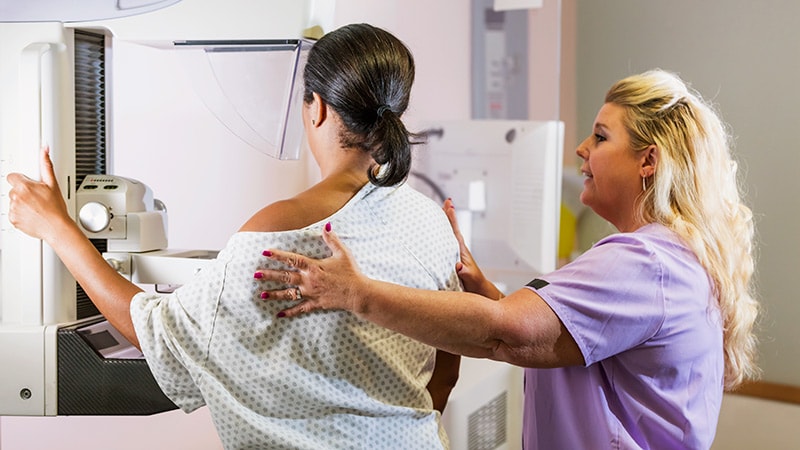False-Positive Mammogram Results Linked to Reduced Screening Rates in Subsequent Years
核心概念
False-positive mammogram results can lead to a significant decrease in the likelihood of women returning for future routine breast cancer screenings.
摘要
The study analyzed over 3 million screening mammograms from more than 1 million women aged 40-73 at nearly 200 facilities between 2005-2017. The researchers classified the mammography results as either true-negative or false-positive, with false-positive results requiring additional imaging, short-interval follow-up, or biopsy recommendations.
The key findings are:
Nearly 10% of women received false-positive results, with 5.8% needing additional imaging, 2.7% needing short-interval follow-up, and 1.3% recommended for biopsy.
Women were more likely to return for screening after a true-negative result (76.9%) than after a false-positive result requiring additional imaging (72.4%), short-interval follow-up (54.7%), or biopsy (61.0%).
Asian and Hispanic/Latinx women who received a false-positive result were much less likely to return for a subsequent screening compared to women of the same groups who received a true-negative result.
For women with two screenings within 5 years, receiving a false-positive on the second mammogram was linked to a lower likelihood of returning for a third screening, regardless of the first result.
The authors recommend that physicians educate patients about the importance of continued screening after false-positive results, as these are associated with an increased future risk of breast cancer.
False-Positive Mammograms Reduced Screening Rates Later On
統計資料
Nearly 10.0% (95% CI, 9.1%-10.5%) of women who received screening mammograms got a false-positive result.
5.8% (CI, 5.5%-6.2%) of women with false-positive results needed immediate additional imaging.
2.7% (CI, 2.3%-3.2%) of women with false-positive results needed short-interval follow-up.
1.3% (CI, 1.1%-1.4%) of women with false-positive results were recommended for a biopsy.
76.9% of women returned for screening after a true-negative result.
72.4% of women returned for screening after a false-positive result requiring additional imaging.
54.7% of women returned for screening after a false-positive result requiring short-interval follow-up.
61.0% of women returned for screening after a false-positive result recommended for a biopsy.
引述
"Physicians should educate their patients about the importance of continued screening after false-positive results, especially given the associated increased future risk for breast cancer."
從以下內容提煉的關鍵洞見
by Edited Mia S... 於 www.medscape.com 09-05-2024
https://www.medscape.com/viewarticle/false-positive-mammography-results-linked-reduced-rates-2024a1000g2q
深入探究
What factors contribute to the lower screening rates among Asian and Hispanic/Latinx women after receiving false-positive mammogram results?
The study highlights several factors that contribute to the lower screening rates among Asian and Hispanic/Latinx women following false-positive mammogram results. Firstly, cultural perceptions and beliefs about healthcare can significantly influence these populations' responses to medical recommendations. For instance, there may be a lack of trust in the healthcare system or a belief that the risks associated with further screenings outweigh the benefits. Additionally, language barriers and limited access to culturally competent healthcare providers can hinder effective communication about the importance of follow-up screenings.
Moreover, the emotional impact of receiving a false-positive result can lead to anxiety and fear, which may deter these women from returning for future screenings. The study indicates that the decrease in return rates for Asian and Hispanic/Latinx women was notably pronounced, with reductions of 20-25 percentage points for short-interval follow-ups and 13-14 percentage points for biopsy recommendations. This suggests that targeted interventions are necessary to address the unique challenges faced by these groups, including education about the implications of false-positive results and the importance of regular screenings for early detection of breast cancer.
How can healthcare providers effectively communicate the importance of continued screening to patients who have received false-positive results in the past?
Healthcare providers can adopt several strategies to effectively communicate the importance of continued screening to patients who have received false-positive results. Firstly, it is crucial to provide clear, empathetic, and culturally sensitive communication. Providers should take the time to explain the nature of false-positive results, emphasizing that they do not necessarily indicate the presence of cancer but rather the need for further investigation to ensure peace of mind and health safety.
Utilizing visual aids and educational materials that are easy to understand can help demystify the screening process and alleviate fears associated with false-positive results. Additionally, healthcare providers should encourage open dialogue, allowing patients to express their concerns and questions. This can foster a trusting relationship and make patients feel more comfortable discussing their health.
Moreover, follow-up reminders and support systems, such as phone calls or text messages, can serve as gentle nudges for patients to return for screenings. Engaging community health workers or patient navigators who understand the cultural context of Asian and Hispanic/Latinx communities can also enhance outreach efforts and improve screening rates.
What are the long-term health implications of reduced screening rates following false-positive mammograms, and how can these be mitigated?
The long-term health implications of reduced screening rates following false-positive mammograms are significant, particularly concerning breast cancer outcomes. Women who do not return for regular screenings may miss early detection opportunities, leading to later-stage diagnoses when treatment options are more limited and less effective. This can result in poorer prognoses and increased mortality rates among populations that already face disparities in healthcare access and outcomes.
To mitigate these risks, healthcare systems must implement targeted interventions aimed at improving screening adherence. This includes developing community outreach programs that educate women about the importance of regular mammograms, especially after experiencing false-positive results. Additionally, integrating reminders and follow-up systems into electronic health records can help ensure that women receive timely notifications for their next screenings.
Furthermore, addressing systemic barriers such as access to care, transportation, and financial constraints is essential. Providing resources such as transportation assistance, financial aid for screenings, and culturally tailored educational materials can empower women to prioritize their breast health. By fostering an environment that supports continuous engagement with healthcare services, the negative long-term health implications of reduced screening rates can be significantly alleviated.
0
